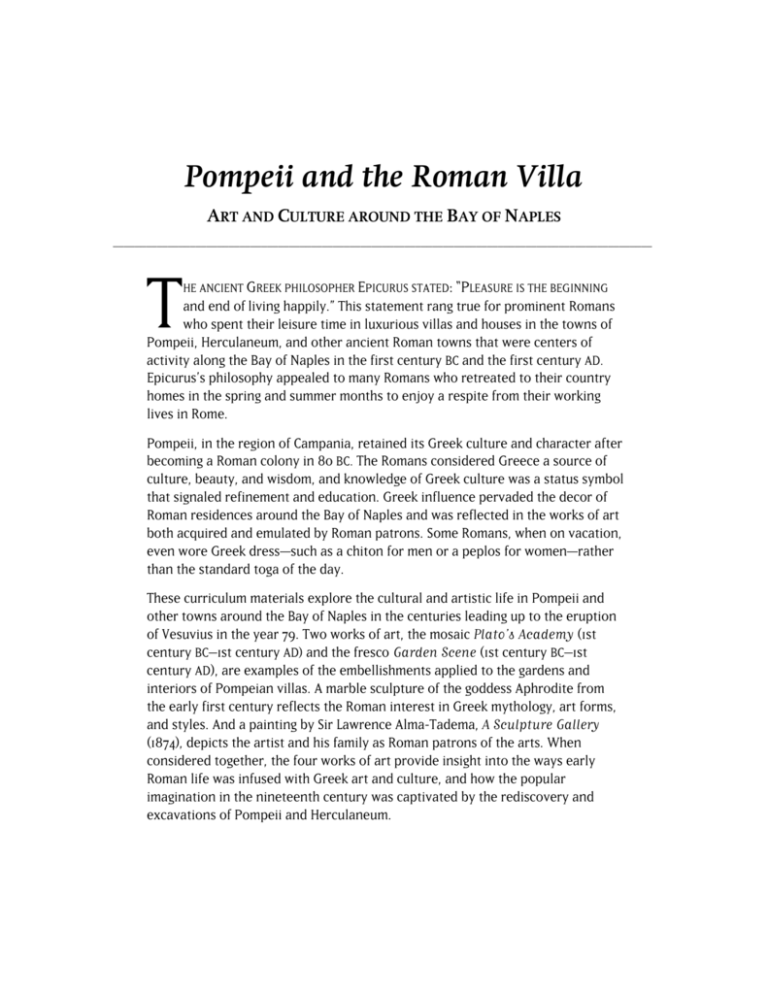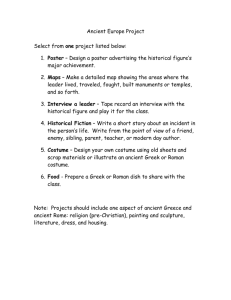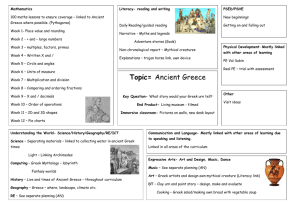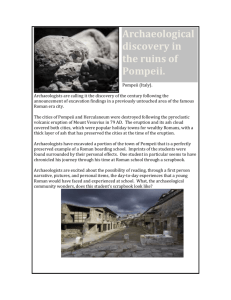
Pompeii and the Roman Villa
ART AND CULTURE AROUND THE BAY OF NAPLES
__________________________________________________________________________________________________
T
HE ANCIENT GREEK PHILOSOPHER EPICURUS STATED: “PLEASURE IS THE BEGINNING
and end of living happily.” This statement rang true for prominent Romans
who spent their leisure time in luxurious villas and houses in the towns of
Pompeii, Herculaneum, and other ancient Roman towns that were centers of
activity along the Bay of Naples in the first century BC and the first century AD.
Epicurus’s philosophy appealed to many Romans who retreated to their country
homes in the spring and summer months to enjoy a respite from their working
lives in Rome.
Pompeii, in the region of Campania, retained its Greek culture and character after
becoming a Roman colony in 80 BC. The Romans considered Greece a source of
culture, beauty, and wisdom, and knowledge of Greek culture was a status symbol
that signaled refinement and education. Greek influence pervaded the decor of
Roman residences around the Bay of Naples and was reflected in the works of art
both acquired and emulated by Roman patrons. Some Romans, when on vacation,
even wore Greek dress—such as a chiton for men or a peplos for women—rather
than the standard toga of the day.
These curriculum materials explore the cultural and artistic life in Pompeii and
other towns around the Bay of Naples in the centuries leading up to the eruption
of Vesuvius in the year 79. Two works of art, the mosaic Plato’s Academy (1st
century BC–1st century AD) and the fresco Garden Scene (1st century BC–1st
century AD), are examples of the embellishments applied to the gardens and
interiors of Pompeian villas. A marble sculpture of the goddess Aphrodite from
the early first century reflects the Roman interest in Greek mythology, art forms,
and styles. And a painting by Sir Lawrence Alma-Tadema, A Sculpture Gallery
(1874), depicts the artist and his family as Roman patrons of the arts. When
considered together, the four works of art provide insight into the ways early
Roman life was infused with Greek art and culture, and how the popular
imagination in the nineteenth century was captivated by the rediscovery and
excavations of Pompeii and Herculaneum.
The Legacy of Greece
The rise of Pompeii as a center of artistic and cultural
activity is tied to the expansion of Roman authority in
the region of Campania. The Greeks colonized the Bay
of Naples and founded Neapolis, modern-day Naples,
around 600 BC. The Roman conquest of Greece in 146
BC spurred an interest in the country’s past, including
its mythology and its artistic traditions. When Rome’s
rule of law expanded to Pompeii in 80 BC, the region
had strong ties to Greek art and culture. Rome’s
reverence for Greece reached its pinnacle under the
leadership of the Roman emperor Augustus (reigned
27 BC–AD 14).
•
In what ways are contemporary society
influenced by ancient Greece and Rome?
Roman Homes and Seaside Villas
Before the eruption of Vesuvius in the year 79,
Pompeii, Herculaneum, and other towns around the
Bay of Naples thrived as centers of trade in wine,
olive oil, and seafood. They produced abundant
harvests of fruits and vegetables, and served as
entry points for shipments of grain from the then
Roman province of Egypt. Many vacationing Romans
were attracted to the area for its temperate climate,
natural beauty, hot springs, and Greek heritage.
Around the second century BC, Roman
aristocrats began building houses and larger villas
in the region. Over the next two centuries, ruling
families also constructed estates there, and the
influx of prominent residents brought incredible
wealth to the area. Julius Caesar, Tiberius, and Nero
were among the rulers who had residences on the
bay. Augustus also built a grand villa on the nearby
Isle of Capri.
The home played an important role in Roman
social rituals; it was the center of business and
entertainment. In most Roman houses and larger
villas, the main entry led to an atrium that opened
to the sky to bring light into the interior rooms and
allow rain water to collect in an impluvium, a
square basin set below floor level. Water from the
impluvium was channeled into an underground
cistern for everyday use. Other rooms opened off
of the atrium, including the kitchen, the triclinium
or dining room, and the tablinum, which served as
both a place to showcase family archives and as a
home office in which to conduct business.
•
How does the Roman house compare to houses
today?
For the wealthy owners of large villas, enjoying
leisure was a primary motivation for living around
the Bay of Naples. The facades of many villas were
lined with colonnaded walkways with sweeping
views of the sea and terraces that connected to
private harbors for pleasure boats. Villa interiors
were decorated with colorful frescoes and mosaics,
whose images often represented mythological
scenes, and still lifes celebrating local delicacies,
such as shrimp, octopus, and conch. Others, such
as the Garden Scene fresco, featured lush landscapes that visually expanded interior spaces.
Garden design was an important part of this
elegant lifestyle. Villas’ interior and exterior
gardens were embellished with aviaries, fountains,
and watercourses, as well as marble and bronze
sculptures. These lavish spaces, and the villas that
housed them, brought pleasure to guests and
residents and were also conspicuous displays of
the social status and authority of the villa owners.
•
In what ways do we incorporate nature into
our interior spaces today? How do we use
gardens and outdoor spaces?
Reviving the Golden Age of Greece
Romans held Greek civilization in high regard and,
like us, considered fifth-century-BC Greece to be the
region’s golden age, a time characterized by refined
artistic and cultural production, scholarship, and
military strength. During his reign five hundred
years later, Augustus sought to align his rule with
this era and promote a rebirth of the golden age
of Greece in Rome. Augustus’s interest in Greek
art and culture strengthened Roman reverence
for classical Greek art, philosophy, and intellectual
life. Knowledge of Greek culture became a mark of
refinement and a symbol of an individual’s social
status. The works of art collected by prominent
Romans further reflected their familiarity with
Greek history, art, and literature.
After the conquest of Greece, many Roman
generals brought works by Greek masters back to
Italy. Many of these works of art were incorporated
into the collections of wealthy patrons of the arts.
As Pompeii and other towns around Naples developed into leisure destinations, local artists began to
produce works of art in the Greek style to meet the
demand for busts, statues, and paintings to decorate
Roman homes. The naturally draping fabric and
realistic posture of the sculpture of the goddess
included in these materials references classical
Greek statuary and exemplifies the Roman taste
for Greek antiquities. Around the early first century
BC, when this sculpture most likely was made, many
Roman art collections were a combination of Greek
originals, or works thought to be Greek originals,
and works made by local artists to emulate or copy
Greek masterpieces.
Villa owners often installed in their gardens
bronze and marble sculptures that recalled Greek
myths and famous Greek writers or philosophers.
The garden was viewed as a place of learning in the
tradition of the pastoral setting of Plato’s Academy.
Founded in the fourth century BC in Athens, the
Academy was dedicated to scholarly and intellectual
pursuits. The hallowed location of the Academy is
represented in the mosaic Plato’s Academy (1st
century BC—1st century AD) included in these
materials.
•
If you could select an image from any time in
history to decorate a wall in your home, what
would it be? What does your selection say
about you?
Destruction and Discovery
When Mount Vesuvius erupted in the year 79,
Herculaneum and all but the highest points of
Pompeii were completely buried under tons of ash
and other volcanic matter. In the aftermath of the
eruption, Greek historian and biographer Plutarch
wrote: “Those who went there by daylight felt
ignorance and uncertainty as to where Pompeii
and Herculaneum had been situated.” Cities located
farther from Vesuvius were largely unaffected,
although many towns and villas in close proximity
to the mountain were abandoned and mostly
forgotten until their rediscovery in the eighteenth
century.
Twenty-five years later, in 104, Roman
magistrate and author Pliny the Younger wrote
two letters to his friend Tacitus, a Roman historian,
describing the eruption of Vesuvius. He had
witnessed the eruption from his uncle’s villa in
Misenum on the northern tip of the bay. In the
letters, he compares the cloud of debris that rose
over the mountain to an umbrella pine that “rose
to a great height on a sort of trunk and then split
off into branches.…” He continued with descriptions
of the massive amounts of ash and pumice that
descended on the area: “Ashes began to fall again,
this time in heavy showers. We rose from time to
time and shook them off, otherwise we should
have been buried and crushed beneath their
weight.” Pliny also described the landscape after
the eruption ended: “Finally a genuine daylight
came; the sun shone, but pallidly as in an eclipse.
And then, before our terror-stricken gaze, everything appeared changed—covered by a thick layer
of ashes like an abundant snowfall.”
Systematic excavations began at Herculaneum
in 1738 and ten years later at Pompeii. In subsequent
years, archaeologists found villas and homes with
furnishings and works of art preserved in the
volcanic ash. The Villa dei Papiri in Herculaneum
was found buried with more than eighty statues and
about a thousand ancient papyri (scrolls) inscribed
with Greek texts. Modern knowledge of ancient
Greek and Roman culture is largely based on what
was unearthed in excavations at Pompeii, Herculaneum, and the other sites around the Bay of Naples.
News of the excavations spread quickly
throughout Europe and sparked the public’s
fascination with ancient Greek and Roman culture.
Numerous poets and writers drafted imagined
stories about life in Pompeii and Herculaneum. The
narratives they created often were characterized by
romantic descriptions of Pompeii in the days before
the eruption or by melancholy reflections on what
remained. English poet Percy Bysshe Shelley (1792–
1822) provides a quixotic remembrance of a visit to
the ancient sites in his Ode to Naples, which begins:
I stood within the City disinterred;
And heard of the autumnal leaves like light footfalls
Of spirits passing through the streets; and heard
The Mountain’s slumberous voice at intervals
Thrill through those roofless halls…
Excavations at Pompeii and Herculaneum fueled the
public’s interest in antique styles and reproductions
of antiquities, which continued throughout the
nineteenth century. Sir Lawrence Alma-Tadema and
other artists were inspired to create paintings that
re-created life and culture of ancient Greece and
Rome. Alma-Tadema made many works of art,
including A Sculpture Gallery (1874), in which
Pompeian antiquities and architectural details are
reproduced in exacting detail, and his own family is
dressed in period clothing.
Plato’s Academy
1ST CENTURY BC—1ST CENTURY AD
__________________________________________________________________________________________________________
I
N THIS MOSAIC, A GROUP OF SEVEN BEARDED MEN ARE
gathered beneath an olive tree. A sundial rests
on a column behind them. Five of the men are
focused on a globe located near the lower center of
the image, while a pair of men on the right gesture
to each other and appear to be in discussion about
a scroll; two men on the far right also are holding
scrolls. The central image is framed by a lush
border of pomegranates, apples, berries, leaves,
and ribbons punctuated by eight male and female
comic masks. See images of similar masks of Silenos,
a satyr associated with drunkenness, and a maenad
on the enclosed CD.
The scene in the foreground is set against the
walls of the Acropolis in Athens, which is represented in the upper right of the mosaic. The men shown
in the foreground are seated in the great Academy,
or gymnasium of ancient Athens, located in a grove
of olive trees that was sacred to the goddess
Athena. The grove consisted of twelve olive trees
grown from cuttings of Athena’s olive tree on the
Acropolis. Plato founded the Academy in the first
quarter of the fourth century BC for teaching,
debating, and conducting research. Scholars studied
in this location for nine hundred years, until the
year 529, when the Byzantine emperor Justinian
(ruled 527–565) forbade non-Christians to teach
philosophy in Athens.
•
This mosaic was made from hundreds of tiny
stone tiles called tesserae. Mosaics also can
be made from tesserae of glass or shell. Take a
close look at the images represented in Plato’s
Academy. Estimate how many different colored
stones the artist used to create this image. How
did the artist use the multicolored tesserae to
suggest dimension and space? Compare the
mosaic to the painting A Sculpture Gallery by
Sir Lawrence Alma-Tadema. How do the artists’
approaches to suggesting space and dimension
differ?
Historians agree that Plato is the man sitting in the
middle of the scene, beneath one of the sacred olive
trees. He sits with bare feet and points to something
on the globe. The identities of Plato’s companions
are less certain. They may be individuals named by
the ancient Roman historian Vitruvius as the great
ancient astronomers, including Pythagoras of Samos
who is best known for developing the Pythagorean
Theorem. Or they may be, as identified by the
Romans who owned the mosaic, the Seven Sages of
ancient Greece, men revered for their knowledge
and wisdom but whose exact identities were
disputed. A similar mosaic was found at an ancient
site in Umbria, Italy, in the eighteenth century,
suggesting that this subject was not new and may
have been based on an earlier painting.
An individual’s scholarship and knowledge,
especially as related to the philosophy and
intellectual life of ancient Greece, was of primary
importance in ancient Roman society. Roman
houses often were built and decorated to enhance
the social status and prominence of the owner.
Images of Greek scholars and philosophers, such
as in Plato’s Academy, often were incorporated
into the embellishment of Roman homes in order
to align the owners with Greek cultural and
intellectual traditions. Mosaics often were placed
on floors, ceilings, and walls.
•
Many ancient Romans decorated their homes
with objects and images that reminded them
of Greek scholarship, philosophy, and art.
What does your home say about you? How
do you select the objects you live with? What
makes them special?
PLATO’S ACADEMY
1st century BC–1st century AD
Pompeii, Villa of Titus Siminius Stephanus,
in suburbs north of Vesuvian Gate, excavated between 1897 and 1900
Mosaic, 33⅞ x 33½ in.
Soprintendenza Speciale per i Beni Archeologici de Napoli e Pompei
Museo Archeologico Nazionale di Napoli
Photo © Luciano Pedicini
Garden Scene
1ST CENTURY BC—1ST CENTURY AD
__________________________________________________________________________________________________________
A
PROFUSION OF PLANTS AGAINST A BRIGHT BLUE
sky greets viewers of this fresco that was
excavated from the House of the Golden
Bracelet in Pompeii. The house was a multilevel
residence located in Pompeii that contained
three similar frescoes in the living room and the
triclinium or dining room. A fresco is a type of
painting made on either wet or dry plaster. Three
living room frescoes faced an outdoor garden that
once contained a fountain, a pool, and a pergola.
The triclinium was also decorated with verdant
garden scenes and opened onto the “real” exterior
garden.
A scalloped birdbath in the center of this
fresco complemented the outdoor water features
in the garden just beyond the living room. Herm
posts (statues in the form of square stone pillars
surmounted by a bust or head) stand on each side
of the birdbath—one with the head of a satyr and
the other with what may be the head of a maenad
or a child. Each herm is also adorned by plaques
with reliefs of sleeping women. Theatrical masks
hang along the top of the fresco. The masks and
other sculptures are all brightly painted, supporting
research into ancient Greek and Roman sculpture
that reveals that classical sculpture was originally
embellished with multiple colors. Take a closer
look at a pair of similar masks on the enclosed CD.
This fresco and the others it was found with
faced an actual garden and served to open up the
walls of the living room to create the illusion of a
greater expanse of garden. The birds and plants
depicted were characteristic of ancient Roman
gardens. And in this garden, there are perpetually
blooming flowers, singing birds, and blue skies.
Flowers and vegetation appear throughout
ancient Greek and Roman mythology and scholarship.
Water and plants were thought to foreshadow the
beauties of paradise promised to the followers of
Bacchus the god of wine and theater, and the Roman
poet Virgil praised flowers and plants for their beauty
in his writings. The garden also was seen as a place
for learning, an idea rooted in the pastoral setting
of Plato’s Academy and referenced in the mosaic
highlighted on the previous page. Gardening and
the incorporation of nature into urban spaces
played important roles in Roman life. The size of
gardens varied based on space constraints, and
they commonly ranged from small kitchen gardens
to lush, large, elaborately designed private meccas.
•
In what ways are gardens, parks, and other
open spaces incorporated into the communities
in which we live? What role do these areas play
in daily life? Consider home gardens and
yards, public gardens, town squares, and
national parks.
The Aqua Augusta, an aqueduct built by Octavian (63
BC–AD 14; later known as Augustus, the first emperor
of the Roman Empire), was completed in the late
first century BC and provided an uninterrupted
supply of pressurized water to eight towns around
the bay, including Pompeii. The arrival of a constant
source of running water in these cities allowed
residents to design and grow more elaborate
gardens. Gardeners were able to accentuate their
landscape designs with springs, water courses,
pools, and fountains modeled after Greek statuary.
Residents also cultivated crops, and some large
gardens included orchards. Pomegranates, figs,
chestnuts, and pears were commonly grown, as
were violets, roses, and hyacinths. Other plants
and flowers common to ancient Roman gardens
are documented in this fresco. Familiar plants
such as laurel, oleander, sycamore, roses, daisies,
chamomile, and poppies are represented. A variety
of birds also can be identified. From left to right,
they are a barn swallow, a rock dove, a turtledove,
a black-billed magpie, a wood pigeon, two house
sparrows, a golden oriole, a blue rock thrush, and
another wood pigeon.
GARDEN SCENE
1st century BC—1st century AD
Pompeii, House of the Golden Bracelet
Room 32, left wall, excavated between 1978 and 1983
Fresco, Second Style, 78¾ x 140⅝ in.
Soprintendenza Speciale per i Beni Archeologici de Napoli e Pompei, Ufficio Scavi, Pompei
Photo © Luciano Pedicini
Aphrodite/Venus
PROBABLY EARLY 1ST CENTURY
__________________________________________________________________________________________________________
A
PHRODITE, GODDESS OF LOVE AND BEAUTY, WHO
is also known by her Roman name, Venus,
is shown here wearing a thin chiton or tunic
under a heavy mantle. The chiton has slipped to
reveal her right shoulder; the fabric of her clothing
drapes, folds, and clings to reveal the shape of her
body. Her wavy hair is held down by a diadem and
is fastened in a bun at the base of her neck. The
representation of the fabric and the human form
beneath, as well as the natural posture of the figure,
suggest the artist’s knowledge of classical Greek
statuary of the second half of the fifth century BC.
The fifth century BC is known as the golden
age of ancient Greece. Greek art from this time
is characterized by a realistic rendering of human
anatomy and the movement of the body through
space. Many variations of this type of statue were
made, but some scholars associate this sculpture
with the work of the Greek artist Agorakritos. He
was an Athenian artist of the fifth century BC and
a student of the renowned ancient Greek artist
Pheidias.
Around the first century BC and the first century
AD, there was great demand for works of art to
decorate the villas and houses of wealthy Romans.
Artists from Rome and Greece relocated to Pompeii
and other cities around the Bay of Naples to take
advantage of the increasing patronage. Works of
art recovered from these residences suggest that
collectors at this time shared artistic preferences,
particularly a taste for the art of classical Greece.
Many Romans prized copies of or adaptations of
works by Greek “old masters” and took pride in
owning works of art that referenced the famous
artists of ancient Greece.
Works of art inspired by ancient Greek sculpture
often took on new forms and meanings in the
Roman home. In Greece, monumental statues of
gods and goddesses were placed in sanctuaries and
public spaces, but in villas and houses around the
Bay of Naples, formerly public art became private
and, often, decorative and functional pieces. For
example, a sculpture of Apollo, the god of learning
and music, was made to hold a tray and placed in
a Pompeian home. Smaller sculptures and figurines
of gods and heroes adorned tables, and wellknown scenes from Greek mythology were used
to ornament drinking cups and bowls.
Roman patrons imported valuable and exotic
materials to be carved into sculptures, vases, cups,
and other domestic furnishings. This Aphrodite was
carved from Pentellic marble imported from Athens;
other sources were Parian marble from the island of
Paros and black basanite imported from Egypt.
•
Ancient Greek and Roman mythology tell stories
about the relationships between humans and
the gods. The goddess Aphrodite (Venus) is one
of a pantheon of gods and goddesses the
ancient Greeks and Romans endowed with
unique powers and characteristics. Myths
about gods, heroes, and heroines often explain
something about the order of the universe or
the relationships between the gods and man.
Make a list of mythological and legendary
heroes and heroines. What makes these figures
memorable? Select a hero or heroine from the
list who holds special importance for you.
Write a description of that figure. From which
culture does he or she originate? In what ways
is the hero or heroine important to your life?
APHRODITE/VENUS
(Syon House/Munich type)
Probably early 1st century
Rione Terra at Puteoli (Pozzuoli)
Pentelic marble from near Athens, 80¾ in.
Sopritendenza Speciale per i Beni Archeologici di Napoli e Pompei
Museuo Archeologico dei Campi Flegrei, Baia
Photo © Mimmo Jodice/Contrasto
SIR LAWRENCE ALMA-TADEMA (THE NETHERLANDS, 1836–1912, ACTIVE ENGLAND)
A Sculpture Gallery, 1874
____________________________________________________________________________________________________________
S
IR LAWRENCE ALMA-TADEMA DEPICTS HIMSELF AND HIS
family as Roman art collectors in his painting
A Sculpture Gallery (1874). Alma-Tadema, with
red hair and beard, sits near the left edge of the
image between Ellen Gosse, his sister-in-law, and her
husband, Edmund Gosse. Alma-Tadema’s wife, Laura,
stands with their daughters, Anna and Laurense. The
works of art shown in the gallery are a collection of
well-known Greek, Roman, Renaissance, and eighteenth-century works. The variety of objects references
the types of prized souvenirs that eighteenth-century
travelers may have brought home from their Grand
Tour through Europe.
A Roman slave, identified by the tablet he wears
around his neck, shows the family a basin with a base
made in the form of the sea monster Scylla. The basin
in the painting references an ancient basin (labrum)
that was mounted onto a modern base similar to the
one in the painting. Alma-Tadema included detailed
references to Greek and Roman antiquities in many
of his works of art. His paintings of domestic life set
in ancient Rome appealed to the nineteenth-century
public’s infatuation with Greek and Roman culture
that was fueled by the rediscovery and excavations
of Pompeii and Herculaneum.
Alma-Tadema made many trips to the excavation
sites to satisfy his curiosity and to do research for his
work. In 1883, during one trip to Pompeii, he wrote:
“Pompeii is still the great attraction. We go there daily,
I study it thoroughly. It is so quaint, so interesting, so
sad, so terrible, so poetical, so bewitching, that really
I dread to come to an end with it. Every day one loves
the place better, as every day one knows a little more
of it.” He conducted extensive research into the art and
culture of ancient Greece and Rome and compiled an
archive of photographs, prints, and drawings, as well
as a library of thousands of books on the subject. His
knowledge enabled him to include accurate references
to antiquity in his imagined representations of domestic
life in ancient Pompeii.
In A Sculpture Gallery, Alma-Tadema included
multiple works of art that were excavated from around
the Bay of Naples, including the sculpture, Young
Hercules Strangling a Serpent, located in the painting’s
upper left, and the statue, the Agrippina Farnese,
located to the right of the basin. He also included a set
of table supports in the lower right that were carved
to resemble those found in the Pompeian house of
Gaius Cornelius Rufus. An image of the table supports
are included on the enclosed CD. Smaller details,
such as the Roman child’s locket that Alma-Tadema’s
youngest daughter wears and the comic mask on
Ellen Gosse’s fan, point to the artist’s research into
the possessions, furnishings, and works of art that
characterized daily Roman life.
When the ancient Roman sites were rediscovered
in the eighteenth century, a vast array of objects was
unearthed that provided detailed information about
Roman life and art. News of the discoveries traveled
fast, and soon a visit to Naples and the excavation
sites became the southernmost stop on the Grand
Tour of the Continent, an extended journey through
Europe taken by wealthy young intellectuals. Tourists
also were intrigued by the periodic bursts of activity
from Mount Vesuvius, which erupted on a smaller
scale several times in the eighteenth and nineteenth
centuries. Popular souvenirs of visits to the Bay of
Naples were paintings of the eruptions and views
of the ruins, as well as jewelry carved from lava.
Publications illustrating the excavated objects were
widely circulated and further spread the rage for
antique styles and reproductions of antiquities. The
rediscovery of Pompeii and Herculaneum affected
the art, design, and culture of Europe and eventually
North America for centuries.
•
The United States Capitol Building is filled with
symbols and architectural details that reference
ancient Greek and Roman art and architecture.
Italian artist Constantino Brumidi (1805–1880)
created a series of murals, based on his study
of Pompeian frescoes, for the Naval Affairs
Committee Room (now the Senate Appropriations
Conference Room) in the Capitol. For information,
visit www.gpo.gov/congress/ senate/brumidi.
Look at the Maenad fresco on the enclosed CD.
This image inspired some of Brumidi’s work. In
what ways do the Pompeian images included in
these materials compare to Brumidi’s images?
What are reasons for referencing classical Greece
and Rome in the design and decoration of United
States government buildings?
Sir Lawrence Alma-Tadema
(The Netherlands, 1836–1912, active England)
A SCULPTURE GALLERY
1874, Oil on canvas, 86½ x 67½ in.
Hood Museum of Art, Dartmouth College, Hanover, New Hampshire
Gift of Arthur M. Loew, Class of 1921A
These curriculum materials were prepared by Elizabeth Mackey and Rachel Bernstein and designed by Jenifer Shell.
© 2009 Museum Associates/Los Angeles County Museum of Art. All rights reserved.
Pompeii and the Roman Villa: Art and Culture around the Bay of Naples is organized by the National Gallery of Art,
Washington, in association with the Los Angeles County Museum of Art, with the cooperation
of the Direzione Regionale per i Beni Culturali e Paesaggistici della Campania and
the Soprintendenza Speciale per i Beni Archeologici di Napoli e Pompei.
LACMA is grateful to Bank of America for their support of this exhibition.
The Los Angeles presentation was made possible in part by LACMA’s Wallis Annenberg Director’s Endowment Fund.
Funding for the concert and symposium was made possible in part by the Istituto Italiano di Cultura of Los Angeles.
The exhibition is supported by an indemnity from the Federal Council on the Arts and the Humanities.
Funding for Evenings for Educators is provided by the Joseph Drown Foundation
and the Kenneth T. and Eileen L. Norris Foundation.
Education programs at the Los Angeles County Museum of Art
are supported in part by the City of Los Angeles Department of Cultural Affairs,
the William Randolph Hearst Endowment Fund for Arts Education and Rx for Reading.










